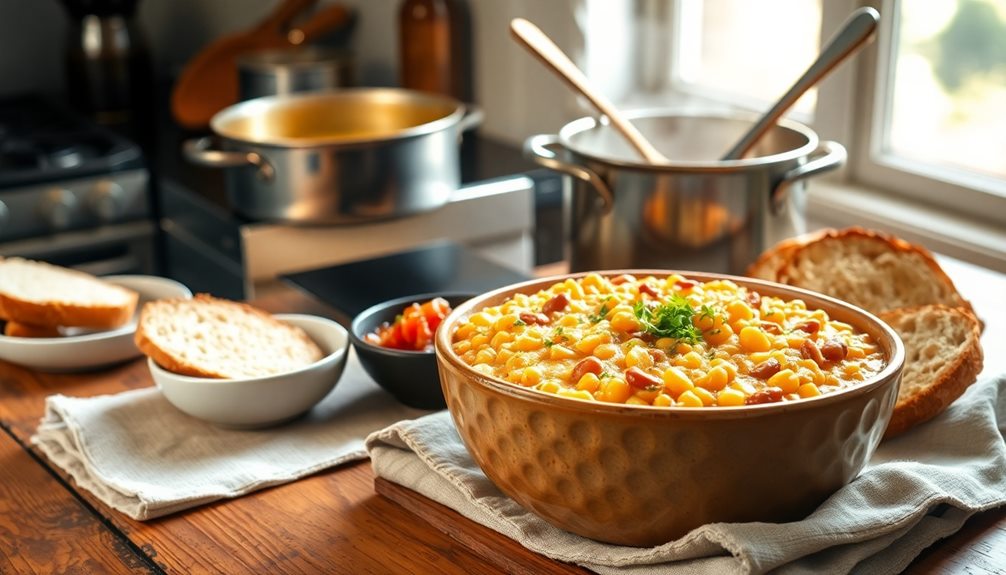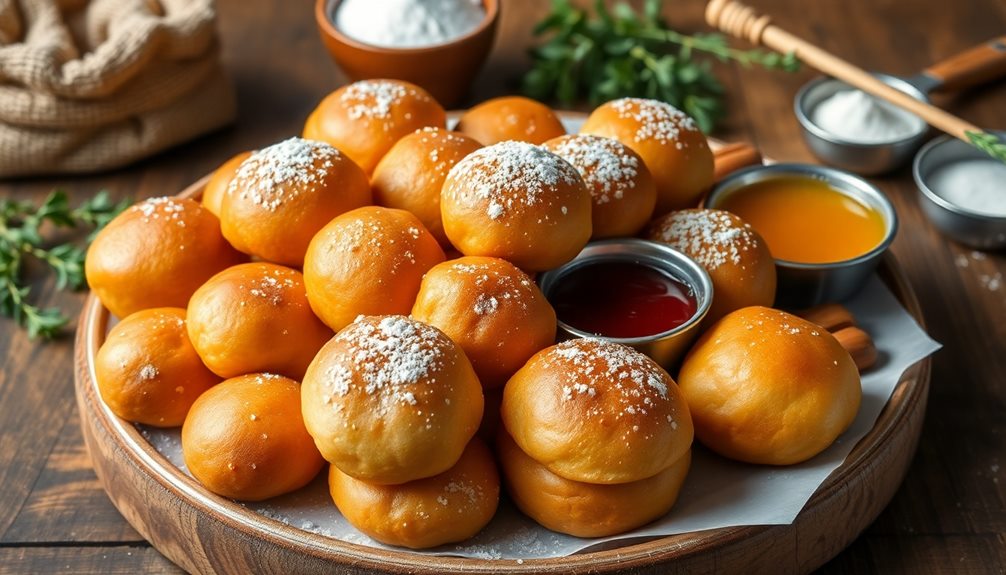South African bread is a delightful mix of cultures and flavors, connecting people through shared traditions. From indigenous grains to European wheat, it brings everyone together. You can explore unique breads like "bunny chow" and "braaibroodjie," each telling a special story. To make your own, gather basic ingredients like flour, yeast, and water. Then, mix, knead, and let the dough rise until fluffy. Shape it into loaves, and soon you'll have warm, homemade bread! This tasty journey reveals more than just recipes, it shows how bread is an important part of community and family life. There's much more to uncover!
Key Takeaways
- South African bread has diverse roots, influenced by indigenous groups and European settlers, symbolizing community across cultures.
- Unique traditional breads include "potbrood," baked in a pot, and "bunny chow," a hollowed-out loaf filled with curry.
- Essential ingredients for bread-making are flour, yeast, salt, sugar, and warm water, with optional milk or butter for added flavor.
- Proper techniques like kneading, allowing dough to rise, and shaping are crucial for achieving the right texture and flavor.
- Traditional South African breads celebrate cultural heritage, fostering connections among families and communities during shared meals.
History
The history of traditional South African bread is rich and diverse, reflecting the country's varied cultures and influences. You might be surprised to learn that bread-making in South Africa has roots that go back thousands of years! Indigenous groups, like the Khoisan, used wild grains and tubers to create their own unique forms of bread.
As time went on, European settlers brought their baking traditions, introducing wheat-based breads that became popular. You can still find these influences today in many households! The famous "potjiekos" and "braai" often feature delicious homemade breads that are perfect for sharing with family and friends.
In South Africa, bread isn't just food; it's a symbol of community and togetherness. Each culture has its own special recipes, like the soft and spongy "bunny chow" or the hearty "braaibroodjie." In gatherings and celebrations, the sharing of bread often goes hand in hand with stories and laughter, emphasizing unity across diverse backgrounds. Similarly, in other parts of Africa, culinary staples play a central role in fostering bonds, such as the beloved Nigerian yam and eggs breakfast, a dish that brings families together in the early hours of the day. These foods, whether baked or cooked, serve as more than sustenance—they are threads that weave the fabric of culture and connection.
These breads tell stories about the people who make them and their traditions.
Cooking Steps
Gather your ingredients and get ready to create a delicious loaf of South African bread. First, you'll need flour, yeast, sugar, salt, and water. If you want to add a twist, consider using seeds or nuts for extra flavor.
Start by mixing the flour, yeast, sugar, and salt in a big bowl. Then, slowly pour in the warm water and stir until it forms a dough. Don't worry if it seems a bit sticky; that's normal!
Next, knead the dough on a floured surface for about 10 minutes. This helps develop the gluten, making your bread nice and fluffy.
Once you've kneaded it, place the dough in a greased bowl, cover it with a cloth, and let it rise in a warm spot for about an hour. You'll know it's ready when it's doubled in size.
After that, punch down the dough to release the air, shape it into a loaf, and place it in a greased pan. Let it rise again for about 30 minutes.
Step 1. Gather Ingredients and Tools

Before diving into baking, you'll need to collect all the essential ingredients and tools for your traditional South African bread. First, gather the main ingredients: flour, yeast, salt, and sugar. Don't forget about warm water, which helps activate the yeast! If you want to add a little flavor, consider incorporating some milk or butter as well.
Next, it's time to get your tools ready. You'll need a large mixing bowl for combining your ingredients and a measuring cup to ensure you've got the right amounts. A wooden spoon or your hands will come in handy for mixing everything together.
If you have a clean kitchen counter or a breadboard, that's the perfect spot to knead your dough. Also, grab a baking tray or a loaf pan, so your bread can rise and bake beautifully. If you have a damp cloth, it's great for covering your dough while it rises.
Lastly, don't forget a timer to track your baking time! With everything gathered and ready, you're all set to create a delicious loaf of South African bread that'll warm your heart and home. Happy baking!
Step 2. Mix Dry Ingredients Thoroughly

Start by combining your dry ingredients in a large mixing bowl. This is where the magic begins! Grab your flour, sugar, salt, and any other dry ingredients from your recipe. Pour them in, and get ready to mix!
Using a whisk or a fork, stir the ingredients together. It's important to mix them thoroughly so that every bite of your bread will taste just right. You want the baking powder or yeast to be evenly distributed, helping your bread rise perfectly.
If you see any lumps, don't worry! Just keep whisking until everything looks smooth and well-blended.
As you mix, imagine the delicious bread that's about to come from your efforts. This step might seem simple, but it's super important. A good mix ensures your bread will have the right texture and flavor.
Once you've blended everything nicely, take a moment to admire your work. You're one step closer to baking something special.
Now that your dry ingredients are ready, you can move on to the next part of your bread-making adventure. Happy mixing!
Step 3. Knead Dough Until Smooth
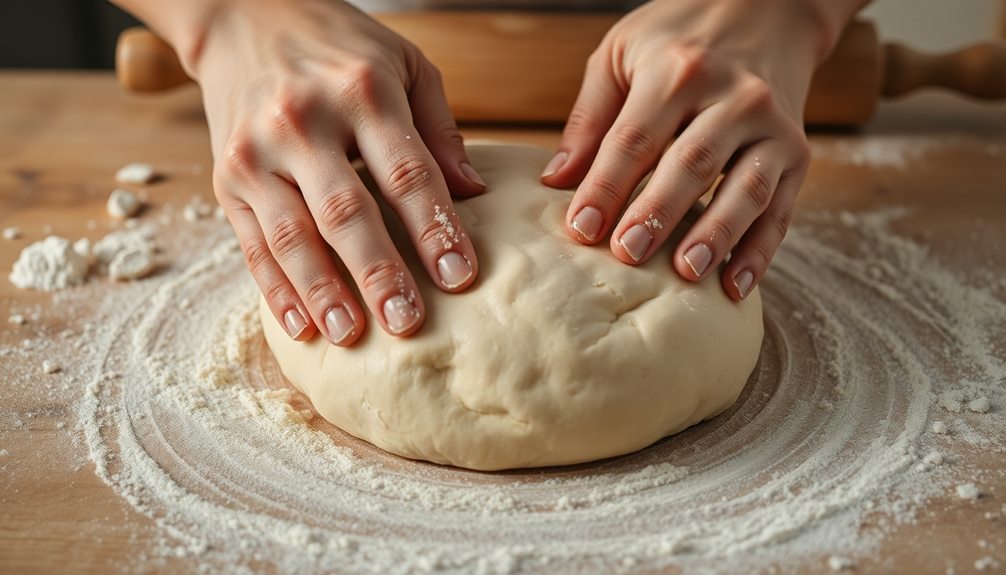
Kneading the dough until it's smooth is a crucial step in creating that perfect texture for your traditional South African bread. When you start kneading, you'll want to sprinkle a little flour on your countertop to keep the dough from sticking.
Grab the dough, and with your palms, push it down and away from you. Then, fold it back over itself and give it a little turn. Repeat this process, adding just a touch more flour if it feels too sticky.
Kneading isn't just about mixing; it's like giving your dough a workout! You'll need to do this for about 8 to 10 minutes. As you knead, you'll notice the dough transforming. It should become smooth, elastic, and a little shiny.
If it feels tough, don't worry! Just keep going, and it'll soften up.
Step 4. Let Dough Rise Properly
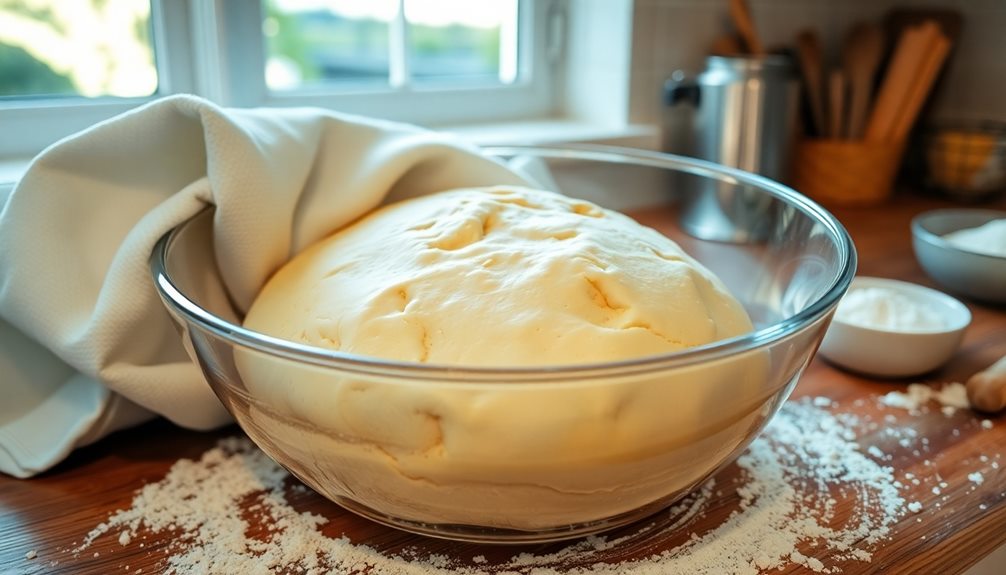
Allowing the dough to rise properly is essential for achieving that light, airy texture in your traditional South African bread. After you've kneaded your dough until it's smooth, it's time for the fun part—watching it grow!
First, place your dough in a warm, draft-free spot. Cover it with a damp cloth or plastic wrap. This helps keep the moisture in, so your dough doesn't dry out. Let it sit for about one to two hours, or until it has doubled in size.
You'll know it's ready when you gently poke it with your finger, and the dough springs back.
If your kitchen is chilly, don't worry! You can turn your oven on to the lowest setting for just a minute, then turn it off. Place the covered dough inside to create a cozy environment.
Step 5. Shape Dough Into Loaves
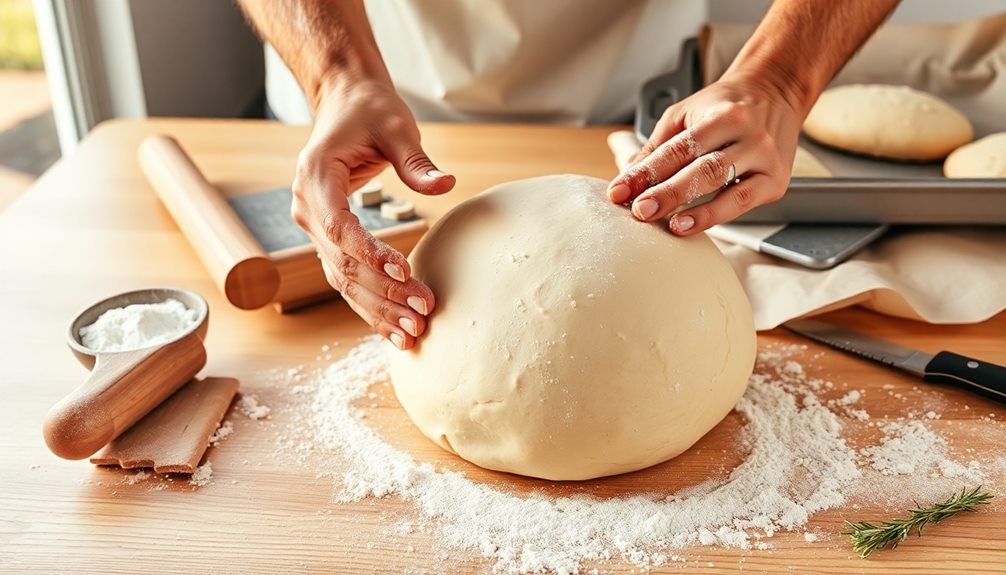
Once your dough has risen beautifully, it's time to shape it into loaves. This is where the magic happens! First, gently punch down the dough to release any air bubbles. Don't worry; it won't hurt the dough at all.
Lightly flour your work surface and turn the dough out onto it.
Now, divide the dough into equal parts, depending on how many loaves you want to make. Roll each piece into a ball, tucking the edges underneath to create a smooth top. Then, flatten the ball slightly and shape it into a rectangle.
Next, fold the rectangle inwards from the sides, and roll it up tightly from the bottom, pinching the seams to seal. Place your shaped loaves seam-side down on a floured baking tray or in a loaf pan.
Cover them with a clean cloth and let them rise again until they double in size—this usually takes about 30 minutes.
Once they've risen, they're ready for the oven! Isn't it exciting to see the dough transform into beautiful loaves? You're just a few steps away from enjoying warm, homemade South African bread!
Final Thoughts
Traditional South African bread is more than just a staple; it's a reflection of culture and community. When you enjoy a warm slice of this bread, you're not just tasting something delicious; you're also experiencing a piece of history.
Each loaf tells a story, whether it's the crusty potbrood cooked over an open fire or the soft, fluffy bunny chow bread that holds a flavorful curry.
As you explore these traditional baked goods, you'll find that they bring people together. Families gather to share meals, friends bond over baking, and communities celebrate with festive bread.
It's amazing how food can create connections, isn't it?
Frequently Asked Questions
What Are the Best Flours for South African Bread Recipes?
When making bread, you'll want to use high-quality flours like bread flour for structure, cake flour for tenderness, and whole wheat for flavor. Experimenting with these can elevate your baking to a whole new level!
Can I Substitute Ingredients for Traditional South African Bread?
Yes, you can substitute ingredients for traditional South African bread. Experiment with different flours, sweeteners, or fats, but remember, these changes may alter the flavor and texture of the final product. Adjust accordingly!
How Long Does South African Bread Typically Stay Fresh?
South African bread usually stays fresh for about two to three days at room temperature. If you want it to last longer, you can freeze it; just make sure to wrap it well to prevent freezer burn.
Are There Gluten-Free Options for South African Bread?
Yes, you can find gluten-free options for South African bread. Many recipes use alternatives like almond flour or rice flour, allowing you to enjoy traditional flavors without gluten. Just check labels or ask your baker for options!
What Beverages Pair Well With South African Bread?
When enjoying South African bread, you'll love pairing it with rooibos tea for a herbal touch, or a light red wine like Pinotage. Don't forget a refreshing craft beer to enhance those savory flavors!




